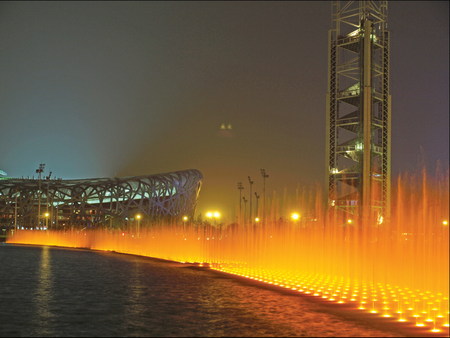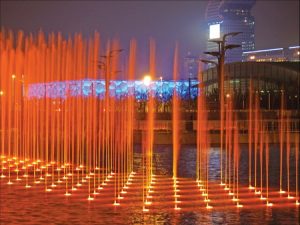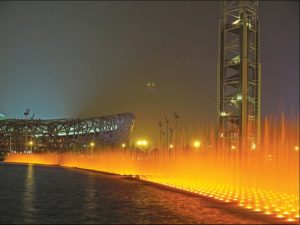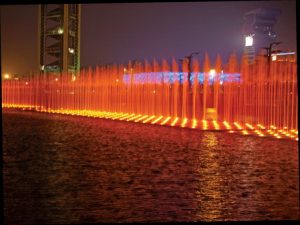China spent approximately $70 billion for the Olympic Games, to transform Beijing into an Olympic city. It was the costliest extravaganza in Olympic history.
In her novel Atlas Shrugged, Ayn Rand used the phrase “the incredible lightness of being” to describe that ingrained human emotion which recognizes a right and just act. She also used it to describe humankind’s achievements, saying it described our enduring desire to reach, build and accomplish.
This year’s 2008 Summer Olympic Games bring Rand’s words to mind. We saw record-smashing athletes; powerful telecommunication technologies; innovative, “green” construction technologies; and most notable to electric signmakers – the incredible light(ness) of Beijing.
Surely, never before, has such imagination and creation been applied to illumination, displays and signage for the Olympic Games’ opening and closing ceremonies. Experienced “LEDvocates,” myself included, expected spectacular displays, but the ultimate views – millions of LEDs, programmed to shimmer and dance – truly exceeded most viewers’ expectations.
The number “8” is lucky for the Chinese, states Onlinechinese-astrology.com. It says citizens pay extra to have the number in their phone numbers or license-plate symbols, and that August 8, 2008 – 08/08/08 – is a very lucky number; thus, for them, it was the best day to begin the Olympics.
Advertisement
On that day, at the $423 million “Bird’s Nest,” China’s new National Stadium (said to be the world’s largest steel structure), more than 90,000 spectators – world leaders included – accompanied by a worldwide audience of (potentially) four billion television viewers, were awed by the actions of 15,000 performers. LED-illuminated drumsticks grasped by 2,008 drummers beat a rhythm while LED-embellished dancers flowed across a latticed blanket of 44,000 LED lamps embedded across the expansive field. Few viewers recognized the technological achievements of this opening event, which was directed by Zhang Yimou, China’s most celebrated film director.
Also notable were the outsized, white (LED) Olympic rings, the logo, on a field of blue. And, although dwarfed by other systems, 10-ft. 2-in.-tall, red channel letters, illuminated with PolyBrite Intl’s (Naperville, IL) Borealis modular, LED lighting system, identified the stadium’s primary entry ways. Beijing’s Trycool Logo and Sign Products Co. built and installed the letters.
Further, the stadium-seated spectators became an LED representation themselves, because each received an LED-lamped, electronic flashlight that included instructions for the audience to interact with the performers. The motion-sensitive, five-color, LED-lamped flashlights (equipped with MEMS-switched accelerometers) detected the holders’ hand-waving action and, therefore, harmoniously changed colors in conjunction with the planned program.
Japan-based Matsushita Electric Industrial Co. (Osaka, Japan) provided 25 Astrovision Technology LED screens inside the stadium and across the city of Beijing. These LED-lamped, grid-mounted boards deflect sunrays and provide a 150° viewing angle and sharp (8mm) imaging. Each unit contains multiple, RGB pixels that operate at 1.6 kHz of response time, thus providing fast-moving images without picture distortion.
Osram Opto Semiconductors (Hong Kong) and Tong Fang Co. Ltd. (Beijing) collaborated to construct the unique, LED-laced, 600-meter-long, dragon-shaped fountains that comprise 1,920 LED lamps (46,080 LEDs total), which illuminated the curvaceous line of dragon-defining fountains.
Advertisement
The concrete and steel “Water Cube” (the Beijing Olympic Aquatic Center), which covered more than 861,000 sq. ft., was clad with 3,000, randomly arranged domes that emulate water bubbles. Each bubble contained a series of Cree Inc.’s (Durham, NC) LEDs (440,000 total) that provided general and animated, display-light systems.
Zhang Yimou placed 6,000 performers into the closing ceremony with ostentatious, LED-lit umbrellas that spelled “London,” the next Summer Olympics site. Consecutively, the Bird Nest’s grand-format LED screens reviewed 2008’s memorable moments.
The artistic LED-illumination applications fulfilled a part of China’s Olympiad effort to go “green.” The nation has been – is – criticized for its vast pollution (it’s the world’s largest CO2 emitter). Nonetheless, the 2008 Olympics in Beijing allowed China to examine and pursue positive, conservation efforts.
In addition to the vast LED displays, solar-powered, LED lamps lit more than 80% of the Olympic complex’s streetlights; and 90% of the Olympic village’s hot water was heated through solar power via more than 1,000 solar panels on the stadium roof. Other green features included a rainwater-collection system for irrigation; an ice-storage cooling system; and a “free” air-ventilation system in the convention center’s foyers.
The 2008 Olympic Games were about sports, technology, China – and the world. In a sense, however, they were reminiscent of Rand’s image – humankind’s search for ever-heightening goals. Perhaps we should allow the “incredible lightness of Beijing” – its sporting achievements and technological accomplishments – to become a type of enduring spirit that helps us set conservation efforts and ideas in our own minds. Such imagery can create renewable strength and energy and move us forward into a constructive and sustainable world.
Advertisement



 Photo Gallery1 week ago
Photo Gallery1 week ago
 Ask Signs of the Times2 weeks ago
Ask Signs of the Times2 weeks ago
 Paula Fargo7 days ago
Paula Fargo7 days ago
 Real Deal4 days ago
Real Deal4 days ago
 Benchmarks2 weeks ago
Benchmarks2 weeks ago
 Photo Gallery7 days ago
Photo Gallery7 days ago
 Women in Signs2 weeks ago
Women in Signs2 weeks ago
 Women in Signs1 week ago
Women in Signs1 week ago












